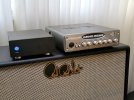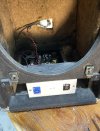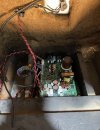Mystic38
Inspired
I wanted to start a D.I.Y Thread for both amps and cabs, so here is the first. DIY amplifiers...mostly because its a great deal easier..lol
I have, in past lives, been lucky enough to work in some fun fields including designing amplifiers and power supplies in the many kW range. I do, however live in the internet so I also probably have a Nobel peace prize so nothing here is a substitute for your own research, using rational sources, and Murphy's law says you will in fact make something not work, or more fun, blow something up and some point in time.
Which brings me to the topic of amplifying our beloved Fractal gear for home and small stage. Yes, you can use Studio monitors, or a PA, or a $1000 wedge or cabinet of some description, but we are in the amps and speakers room so here goes.
For the last 3 years I have been using my Genz Benz Streamliner 900 bass amp for this purpose via the aux in. It has prodigious power reserves, sounds musical and is clean and flat a response as you could possibly wish for. It however, sits atop a 212 cabinet and I wanted to end up with a powered cabinet, and so, not wanted to dedicate a $$ bass amp to the purpose I started to ponder a replacement.
I started to consider a design using a plate amp.. a popular approach, but not the cheapest, and using a full range speaker like the F12-x200 or F12M-150, the extra filter functions was just not needed, however if you want it to be a mixer with extra inputs, its a good choice. I wanted to begin at the lower end of $$$ so I started to look at Class D modules. Note that to make a Class D amp work, you need both a power module and a power supply, and they are not always bundled together.
Initially I researched the Hypex nCore 500.. a phenomenal amp that I am familiar with as it is embedded into several audiophile grade amps costing $$4k & up.. but a design for these would be rather costly and its unclear that the benefits would justify the extra cost. I settled on an IcePower 200ASC that provides 200W into 4 Ohms. for $130. An alternative would be the IcePower 50ASX2BTL, which is the 170W module inside the SD Powerstage 170 for the same price, but note that SD have included an EQ, and are not specifically targeting the PS170 at full range/transparent designs, so it is not clear to me, and i doubt that the default (noon) response is flat.. and that is a requirement for a transparent amp to go with the Fractal gear.
If you are planning on a powered cabinet build the parts list for the amplifier section amounts to about $150 and is simply the following, all from parts express (USA, sorry)
1 IcePower 200ASC Module (integrated amp + power supply)
2. Ice Power 200ASC wiring harness
3. A panel mount XLR socket
4. An IEC receptacle with on/off switch
For my purposes, I also purchased from Ghentaudio.com a DIY case kit for this module ($115) , as my cabinet is going to undergo several transformations... but still its a $200W standalone amp for < $250
Build details to follow..
I have, in past lives, been lucky enough to work in some fun fields including designing amplifiers and power supplies in the many kW range. I do, however live in the internet so I also probably have a Nobel peace prize so nothing here is a substitute for your own research, using rational sources, and Murphy's law says you will in fact make something not work, or more fun, blow something up and some point in time.
Which brings me to the topic of amplifying our beloved Fractal gear for home and small stage. Yes, you can use Studio monitors, or a PA, or a $1000 wedge or cabinet of some description, but we are in the amps and speakers room so here goes.
For the last 3 years I have been using my Genz Benz Streamliner 900 bass amp for this purpose via the aux in. It has prodigious power reserves, sounds musical and is clean and flat a response as you could possibly wish for. It however, sits atop a 212 cabinet and I wanted to end up with a powered cabinet, and so, not wanted to dedicate a $$ bass amp to the purpose I started to ponder a replacement.
I started to consider a design using a plate amp.. a popular approach, but not the cheapest, and using a full range speaker like the F12-x200 or F12M-150, the extra filter functions was just not needed, however if you want it to be a mixer with extra inputs, its a good choice. I wanted to begin at the lower end of $$$ so I started to look at Class D modules. Note that to make a Class D amp work, you need both a power module and a power supply, and they are not always bundled together.
Initially I researched the Hypex nCore 500.. a phenomenal amp that I am familiar with as it is embedded into several audiophile grade amps costing $$4k & up.. but a design for these would be rather costly and its unclear that the benefits would justify the extra cost. I settled on an IcePower 200ASC that provides 200W into 4 Ohms. for $130. An alternative would be the IcePower 50ASX2BTL, which is the 170W module inside the SD Powerstage 170 for the same price, but note that SD have included an EQ, and are not specifically targeting the PS170 at full range/transparent designs, so it is not clear to me, and i doubt that the default (noon) response is flat.. and that is a requirement for a transparent amp to go with the Fractal gear.
If you are planning on a powered cabinet build the parts list for the amplifier section amounts to about $150 and is simply the following, all from parts express (USA, sorry)
1 IcePower 200ASC Module (integrated amp + power supply)
2. Ice Power 200ASC wiring harness
3. A panel mount XLR socket
4. An IEC receptacle with on/off switch
For my purposes, I also purchased from Ghentaudio.com a DIY case kit for this module ($115) , as my cabinet is going to undergo several transformations... but still its a $200W standalone amp for < $250
Build details to follow..





